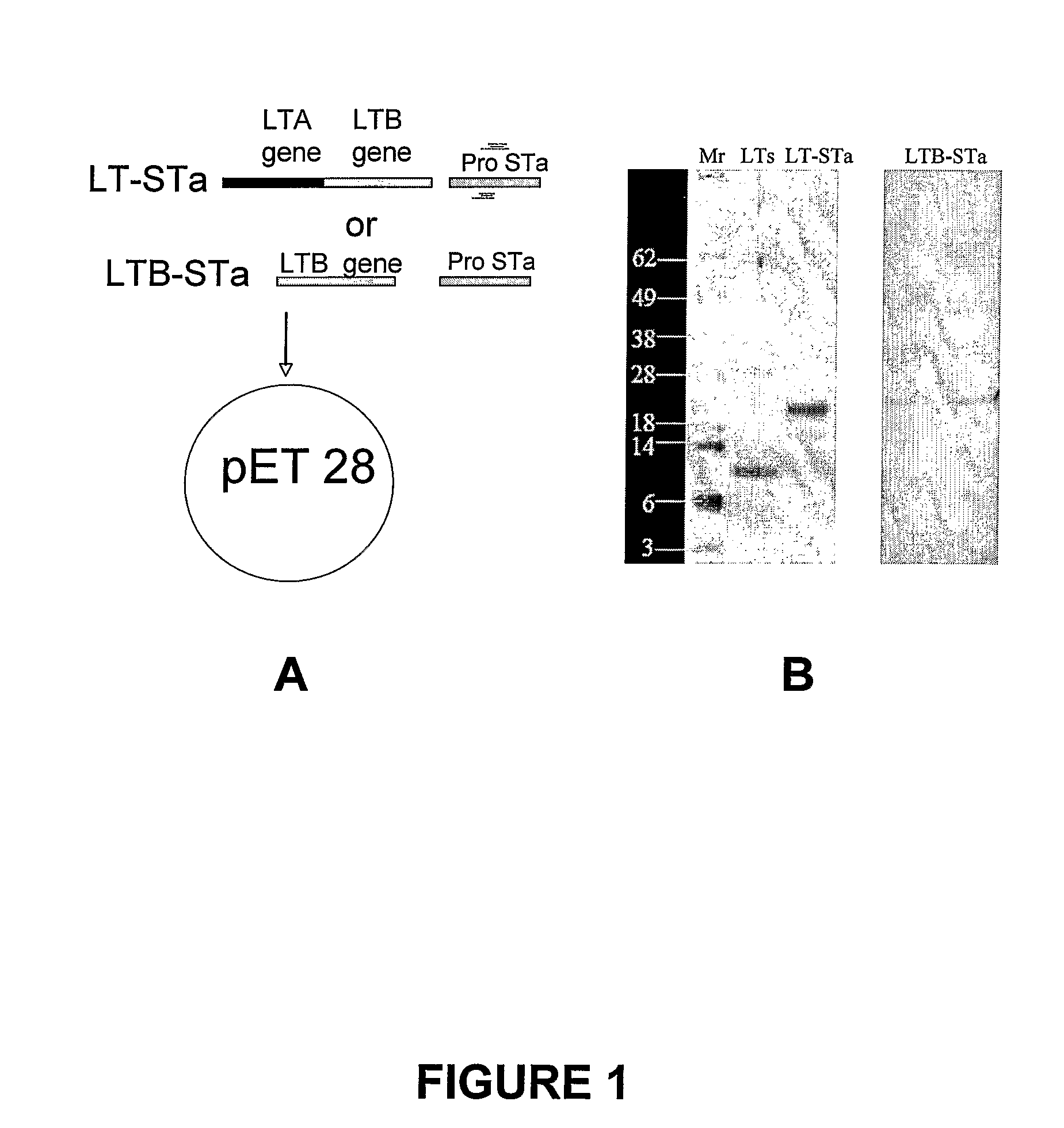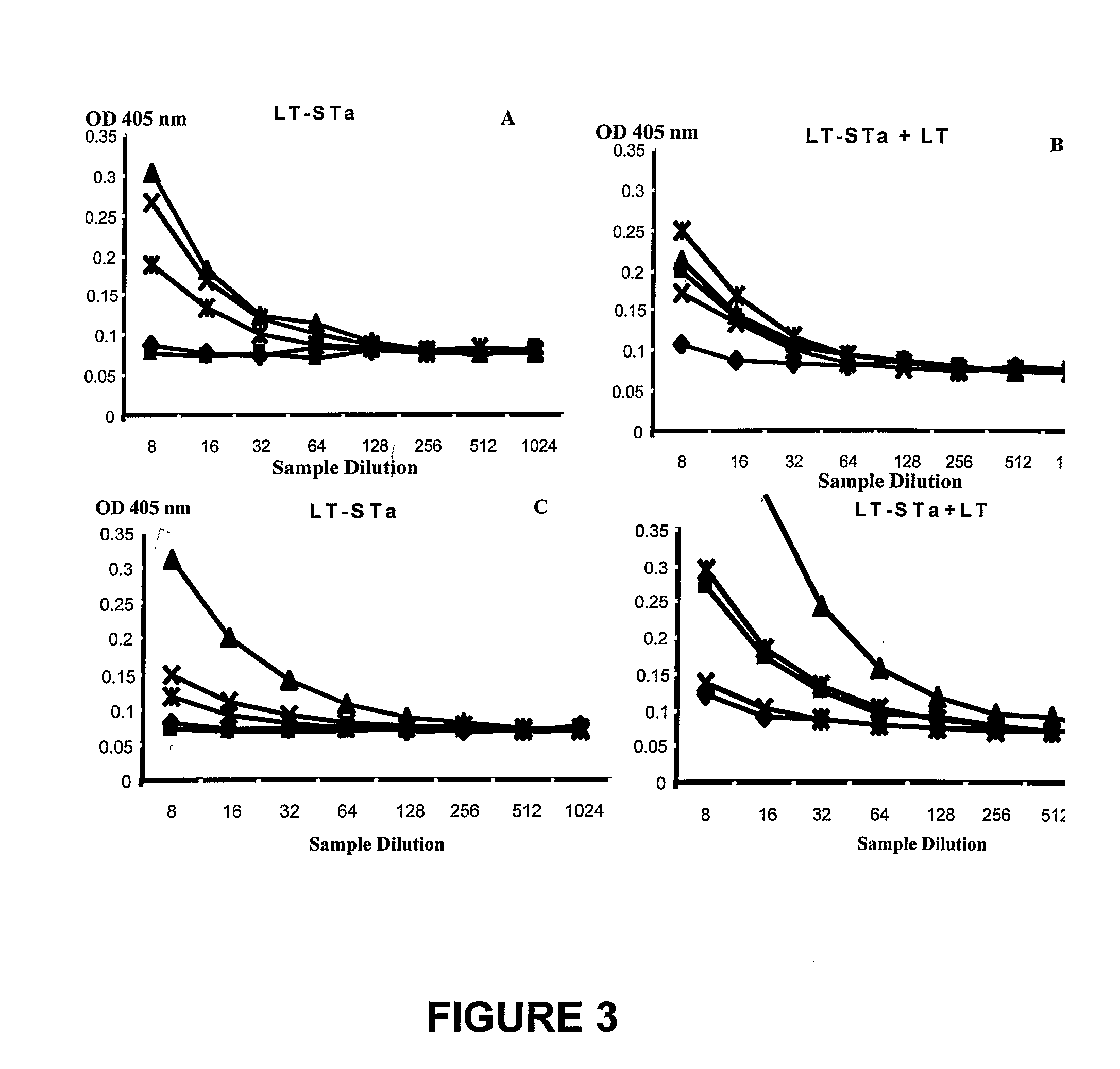Skin immunization using lt-sta fusion proteins
a technology of fusion proteins and skin, applied in the field of skin immunization using lt-sta fusion proteins, can solve the problems of difficult to maintain hygienic measures during travel, difficult to evaluate the relevance of protection of multivalent platforms, and difficulty in cloning, expressing, and optimizing immune responses to multivalent platforms. achieve the effect of enhancing the immune response, enhancing the process of antigen uptake, processing and presentation
- Summary
- Abstract
- Description
- Claims
- Application Information
AI Technical Summary
Benefits of technology
Problems solved by technology
Method used
Image
Examples
example 1
[0123]Construction of LT / pro-STα and LTB / pro-STα fusion proteins. The LT gene (1148 bp), LT-B (378 bp) and the human STa gene (159 bp) were amplified from genomic DNA of the ETEC H10407 strain (for example, ATCC accession no. 35401; other strains are optionally used in the practice of the methods of the invention) using the 5′ and 3′ primers listed in Table 1. The forward primer created a unique Nco1 site and the reverse primer created a BamH1 site on LT and LTB gene. BamH1 and Xho1 restriction sites were created at N-terminal and C-terminal of the STa gene. FIG. 1A. The genes were purified from agarose gels. The expression vector pET28 was digested with Nco1 and Xho1 restriction enzymes. The STa gene was ligated for 3 h at room temperature to the LTAB genes or LTB and the fusion gene was cloned into the pET28 vector. Competent E. coli Mach-1 cells were transformed with the ligation mixture and recombinants selected by growth on LB agar containing 50 μg / ml kanamycin. Preliminary scr...
example 2
[0125]Purification of the LTB-proSTα and LT-proSTα. LTB-proSTa and LT-proSTa fusion proteins were purified from E. coli BL21 by affinity chromatography using immobile D-galactose. The recombinant bacteria were cultured in LB broth containing 50 μg / ml of kanomycin and cultures were grown overnight at 37° C. The next day 1:10 diluted culture were inoculated into LB medium at 37° C. and grown to 0.5˜0.7 at OD600. Cultures were induced with 0.5 mM IPTG for 3 hr. The cells were harvested by centrifugation at 6000 rpm and cells were suspended in TEAN buffer (0.05 M Tris, 0,001 M EDTA, 0.2 M NaC1 at pH 7.5) and lysed by sonication. The crude lysate was clarified by centrifugation twice. The supernate was directly applied to an immobilized galactose column. The column was washed extensively with TEAN buffer. The fusion proteins were eluted with TEAN buffer containing 0.3 M galactose. LT-proSTa and LTB-proSTa were found to bind to the D-galactose affinity column, indicating that the STa did ...
example 3
[0128]Mice were anesthetized and the dorsal caudal surface at the base of the tail was shaved prior to patch application. The shaved skin was hydrated with saline and pretreated with emery paper to disrupt the stratum corneum. A gauze pad on an adhesive backing was loaded (25 μl) with 25 μg LT-STa fusion protein alone or mixed with 10 μg LT. Patches were applied for 18 hr. All mice were immunized on day 0 and 14 and serum was collected two weeks after the second immunization. An ELISA method was used to detect serum antibodies to STa. FIG. 2 represents titration curves for individual animals.
PUM
| Property | Measurement | Unit |
|---|---|---|
| Area | aaaaa | aaaaa |
| Immunogenicity | aaaaa | aaaaa |
Abstract
Description
Claims
Application Information
 Login to View More
Login to View More - R&D
- Intellectual Property
- Life Sciences
- Materials
- Tech Scout
- Unparalleled Data Quality
- Higher Quality Content
- 60% Fewer Hallucinations
Browse by: Latest US Patents, China's latest patents, Technical Efficacy Thesaurus, Application Domain, Technology Topic, Popular Technical Reports.
© 2025 PatSnap. All rights reserved.Legal|Privacy policy|Modern Slavery Act Transparency Statement|Sitemap|About US| Contact US: help@patsnap.com



